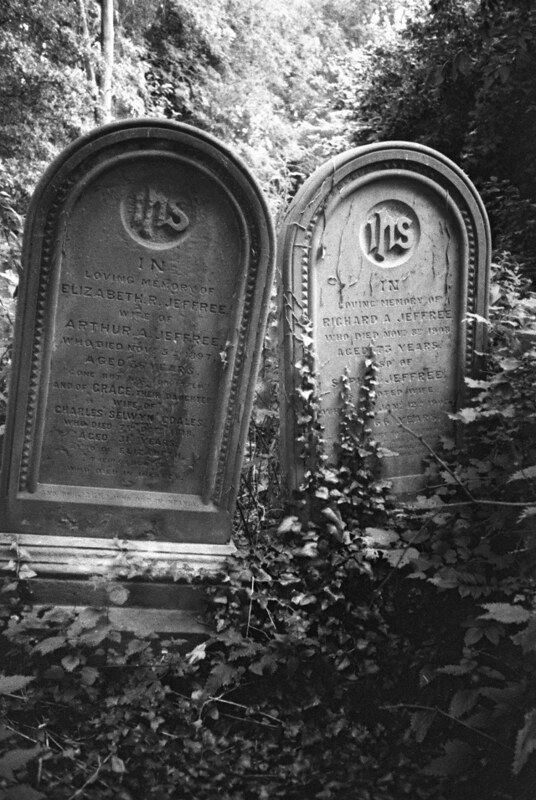
Together in Death. Olympus XA2 (the 50p camera project). AgfaPhoto Vista Plus 200 (Poundland Film) C41. Developed in Rodinal.
I recently asked on a photography forum for a developing recipe to cross process C41 with b/w chemistry. I was tickled, but a little chuffed, when someone answered by giving me a link to an old post about the subject …. from one of my own posts here on my blog!
I hadn’t cross processed Poundland film to b/w for a year or two, and when I did, I used Ilford ID11. This time I wanted to use a rodinal / R09 developer, and I fancied stand processing.
For the Digital / N00b crowd. What am I talking about?
- Cross Processing. There are a number of different processes for film, and for printing. The most common three are a) C41. This is the process for developing colour negative film. Some b/w films have also been produced that require C41. b) E6. This is the process for colour positive transparencies / slides. c) True b/w negative. The oldest process that is usually still done by hand rather than a photo lab. Cross processing takes place when a photographer uses a process other than that intended by the film manufacturer. Many Lomo photographers cross (both ways) C41 and E6 in order to get bizarre colours on prints/scans. I am cross processing C41 Poundland film in b/w chemistry, because it is ultra cheapskate and tight fisted.
- Stand processing. Hand processing film involves agitating or inverting a developing tank filled with a film, and diluted solutions of developer at set intervals. Typical dilutions for example for the rodinal developer are 1:19 or 1:25 of rodinal to water. This moves the diluted developer through the film emulsions at a proven rate. With Stand processing, you use much weaker dilutions of developer, and instead of regular inversions – leave the tank standing for a much longer time. It saves on developer, allows you to have a meal or watch a movie, and is similar in some ways to slow cooking. You can be several minutes out either way without disaster.
The stand process that I ended up using this time was that as suggested by the Massive Dev Chart for XP2 C41 in Rodinal / R09.
The recommendation was 1:100. Yes, a pathetic 3 ml of Agfa Rodinal for a single 35mm film in my Paterson tank. The recommended time at the optimum 20C was 120 minutes. I put my used Poundland film in the tank. Added the very diluted Rodinal, gave it several inversions, then sat it down with a few taps to dislodge air bubbles.
I then took Anita out to the local flea pit (cinema) where we watched the Pixel movie. I returned maybe 130 minutes later. Emptied out the developer, stopped, fixed, and rinsed. Hung up the slippery brown thing to dry.
The above image is one scan. I did enhance the levels a little on the scanned image, using Gimp software, but not that much. I worked out that 3 ml of my Rodinal cost me about 8p (GBP £0.08). The film a quid from Poundland. Altogether, film, develop, fix, and scan cost me no more than £1.30.
Tight fisted?
One more thing. This isn’t just about process and cost. How does the image look?
It looks great! I’ve not tried Rodinal yet, would like to give it a try. It has been a while now since I shot any film (I know, I know) but I do have a few rolls ready to go – maybe into my Rolleiflex one day soon.
Was it really 3 mg of Rodinal you used, not 3 ml? 3 milligrams sounds like a very small quantity indeed. I appreciate that’s the idea with stand developing, but 3 thousandths of a gramme?
Sh…. Yeah did I really say mg? I’m going to have to correct that ha ha.
So ml, millilitres? I’ll probably refer back here when I do get around to it 🙂 Would also like to try exactly what you did here, C41 processed with b&w chemicals. Your results show that this seems to be a great way to shoot b&w on the cheap! I’ll be off to Poundland next time I’m in town 🙂
So use to mg at work doh! If you do it, the films look yucky brown. It is the power of a scanner to make sense of them.
You make this sound all the more intriguing! Looking forward to giving it a go.
You’ve got much better results than when I tried it. I used HC110 and devd as if for HP5. Unusable rubbish.
You’ve proved it can be done though.
Being a simpleton, I like to stick with one developer for everything, but I might have to re-think that.
Have processed Poundland film in D76 before using times for XP2 from the massive chart. Negatives were incredibly dark (though I was also having trouble with a sticky shutter on an eBay XA), though some scanned OK.
I like how the tombstones are leaning together, as if they were heads.
Hi, are there any particular fix and stop that you use with this process or will any B/W chems work?
Hi Mark, to be honest, the next time that I used this system, the results were poor! It can be very hit or miss. Pretty much most b/w developers/fixers “could” work, but as I have said – a lot of it is down to the scanning.
can you really still buy film in Poundland? Just dusting off my Pentax ME Super for the first time since the 1980’s and want to check for light leaks!
Yes you can. Some stores sometimes run out, and occasionally people panic that it’s all over – but certainly, in all of the local stores that I’ve looked around here – there are stocks of AgfaPhoto Vista Plus 200 x 24